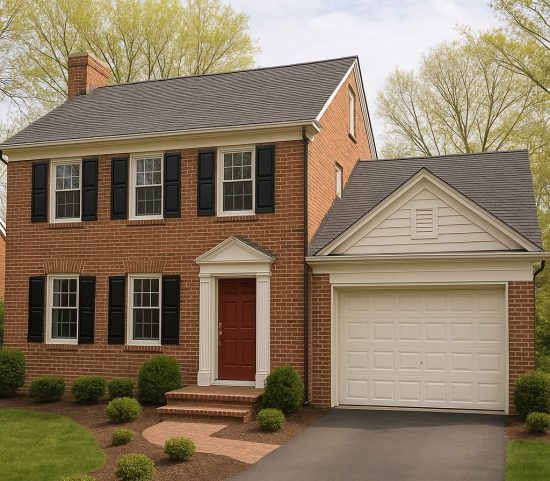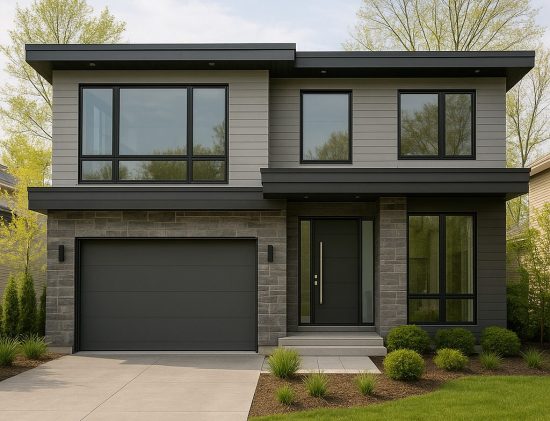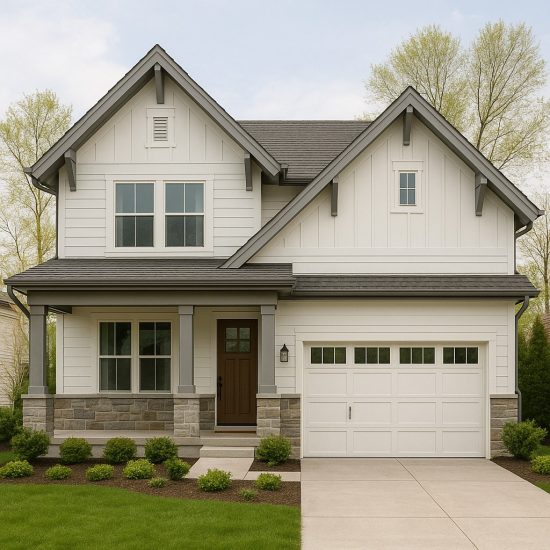Choosing the Right Design for Your Residential Garage Door Installation

By Morristown Overhead & Garage Door Center – Trusted Experts Serving Audubon, NJ & Beyond
When Sarah, a homeowner in Audubon, NJ, called us at Morristown Overhead & Garage Door Center, she was frustrated. Her wooden garage door creaked with every use, the garage door opener often failed, and the insulation was poor, making her garage freezing in winter and hot in the summer. After a thorough consultation, we recommended a residential garage door installation featuring a new insulated steel door with energy-efficient garage door panels and a modern torsion spring system for smooth, safe operation. Today, Sarah enjoys a quieter, more secure garage that boosts her home’s curb appeal and saves on energy bills.
Across the country, homeowners are discovering that a garage door isn’t just a utility—it’s an investment. According to a 2024 Cost vs. Value report, a new garage door installation can offer over 100% return on investment during resale. That makes selecting the right design not just a personal preference but a financial decision.
If you’re planning a residential garage door installation, the choices can feel overwhelming. With so many styles, materials, and technical details—like brackets, hinges, insulation, and tracks it’s important to get it right the first time. This comprehensive guide will walk you through every aspect of the process, helping you choose a garage door that enhances your home, performs reliably, and fits your needs perfectly.
Why the Right Garage Door Design Matters
Your garage door is often the largest moving part of your home. It takes up significant visual space and plays a critical role in your home’s security, energy efficiency, and aesthetic appeal. Choosing the wrong design or improper installation can lead to costly repairs, poor insulation, and even safety hazards.
A well-designed garage door should feature high-quality materials, properly installed hinges, strong horizontal and vertical tracks, effective insulation with high R-values, and a dependable garage door opener for smooth operation. These elements, when installed correctly using proper tools like a power drill, vise grip, and accurate drilling techniques, ensure a long-lasting and beautiful addition to your home.
1. Match the Design to Your Home’s Architecture
Every home has a distinct architectural character, and your garage door should reflect and enhance it. Here are some tips for matching your new garage door to your home’s design:
- Traditional or Colonial Homes: Raised-panel garage door sections with symmetrical windows and classic carriage-style hardware (like black iron hinges and handles) provide timeless appeal.

- Modern or Contemporary Homes: Choose sleek aluminum or glass-paneled doors with minimalistic hardware. These designs often include flush garage door panels and frameless glass to maintain clean lines.

- Craftsman or Farmhouse Homes: Look for woodgrain composite materials with vertical groove panels, cross beams, and rustic hinges for charm and character.

When planning a residential garage door installation, visual balance is key. Consider the number of garage door sections (top section, middle panels, bottom panel), the position of the garage wall, and even the alignment with your home’s windows and roofing.
2. Select the Best Material for Performance and Style
Garage doors are available in a variety of materials, each offering distinct advantages. Let’s break down the most popular options:
- Steel Doors: Known for durability and strength, steel is a top choice for homeowners. It supports insulation between layers, has high R-value ratings, and resists weather and impact damage. Look for powder-coated finishes to reduce upkeep and rust.
- Wood Doors: While visually stunning, wood garage doors require regular maintenance and sealing. They’re heavier, which affects spring and track wear, and they may absorb moisture, affecting the door’s operation.
- Aluminum and Glass: Lightweight and resistant to rust, these modern doors suit contemporary homes but offer less insulation unless paired with thermal glass.
- Composite or Faux Wood: These doors combine the beauty of wood with the low maintenance of steel. Great for homeowners looking for longevity without losing aesthetic appeal.
- Vinyl: Resistant to dents and cracking, vinyl doors are a good choice in humid climates, though they may offer fewer style options.
When selecting a material, also consider the torsion springs, garage door brackets, and cables that work best with that door’s weight and structure. A heavier door, for example, may require a reinforced center bracket and torsion tube to support proper operation.
3. Prioritize Insulation and Energy Efficiency
In areas like Audubon, NJ, where temperatures can vary widely, insulated garage doors are a must. Insulation helps you:
- Conserve energy by keeping your garage and adjacent rooms cooler in summer and warmer in winter
- Reduce noise from street traffic and door operation
- Improve strength, insulated garage doors often include thicker panels, reinforced with steel or composite cores
Insulation is measured by R-values; the higher the R-value, the better the insulation. For attached garages, aim for an R-value of at least 12 to 16. Choose polyurethane insulation for the highest thermal resistance and sound-dampening.
Don’t forget the weather stripping, bottom seal, and side brackets that help close any gaps between the garage opening and door edges. These components are vital to the energy efficiency of the system.
4. Choose the Right Color, Finish, and Decorative Features
A garage door’s color and finish can greatly influence your home’s curb appeal. While neutral tones like white, beige, and gray are timeless, modern homeowners are experimenting with bolder colors like deep red, forest green, and matte black.
Textured finishes that mimic wood grains or metallic surfaces are also gaining popularity. These offer durability while maintaining style. When customizing your garage door panels, also consider adding:
- Windows or Lites: These bring in natural light and add style. Choose between arched, square, or rectangular shapes. Frosted or tinted glass adds privacy.
- Decorative Hardware: Hinges, handles, and corner brackets can make a modern door look more traditional, or vice versa.
These upgrades don’t just improve looks, they can also improve visibility inside the garage, assist with light regulation, and impact energy usage.
5. Add Smart Features and Safety Enhancements
Modern garage doors do more than open and close. Today’s systems are built for safety, security, and smart integration. Look for:
- Garage Door Opener with Smart Technology: Connect to your phone or smart home system. Monitor and control the door remotely, receive alerts, or schedule opening/closing times.
- Automatic Reversal System: Uses sensors to detect objects in the door’s path and reverse its motion to prevent injury or damage.
- Battery Backup System: Keeps your garage door opener functional even during a power outage.
- Manual Release Handles and Cable Systems: Ensures safe disengagement during emergencies.
For added protection, make sure your opener system includes reinforced torsion springs, flag brackets, and a secure mounting header.
6. Rely on Professional Installation for a Successful Outcome
While DIY garage door projects may seem appealing, they often overlook the importance of balance, tension, and precise calibration. Improper installation can lead to unsafe operation, misaligned tracks, broken springs, or even property damage.
At Morristown Overhead & Garage Door Center, our trained technicians follow a precise step-by-step guide using necessary tools like torque bars, vise grips, wrenches, and power drills. We secure every bolt, align every vertical track and horizontal track, and ensure your garage door sections move with smooth operation.
We test the door’s tension, inspect each bracket and panel, and confirm that the system meets safe operation standards. Our services include:
- Spring tension adjustment
- Opener motor calibration
- Weather seal installation
- Maintenance and repair of brackets, rollers, and tracks
Professional installation also protects your warranty and provides peace of mind for years to come.
How Can Morristown Overhead & Garage Door Center Help You?
If you’re planning a residential garage door installation in Audubon, NJ, or surrounding areas, let Morristown Overhead & Garage Door Center help you make the perfect choice.
From custom garage doors to professional garage door opener installations, spring repairs, insulation upgrades, and decorative hardware options, we offer a full suite of services backed by expert technicians and decades of experience.
📍 Visit us at: 36 Phoenix Ave, Morristown, NJ 07960
📞 Call us now: (862) 208-2994
🔧 Serving Audubon, Morristown, and surrounding NJ communities
Let’s transform your garage into a safe, stylish, and energy-efficient space. Call us today for a free consultation and discover why we’re the trusted name in garage door installation and service.
FAQs About Residential Garage Door Installation
1. How long does it take to install a new residential garage door?
Most professional installations take about 4 to 6 hours, depending on the size, design, and whether an old door needs to be removed.
2. Do I need to be home during the garage door installation?
It’s recommended to be available at the start and end of the installation for access and final walkthrough, but you don’t need to stay the entire time.
3. Can I reuse my existing garage door opener with a new door?
In many cases, yes, as long as the opener is compatible and in good working condition, but it may require adjustment or reprogramming.
4. What is the average lifespan of a residential garage door?
With proper maintenance, most residential garage doors last 15 to 30 years, depending on materials and usage frequency.

